| Botanical Name |
Malephora crocea var. crocea |
| Family |
Aizoaceae - The fig-marigold family or ice plant family |
| Pronunciation |
|
| Common Name(s) |
English: Copper Vygie; Fingerkanna
USA: Coppery Mesemb; Red-flowered Iceplant; Croceum Iceplant
|
| Plant Group |
- Succulent A plant having fleshy stems or leaves often adapted to dry conditions.
|
| Plant Size |
- Small to Medium
| Tree | 8m to 15m |
| Shrub | 75cm to 1m |
| Perennial/ground cover | 20cm to 40cm |
| Bulb | 30cm to 40cm |
| Succulent | 20cm to 40cm |
|
| Position |
- Partial Shade The area is in shade for part of the day and in full sun for part of the day.
- Sun The area is in full sun for all or most of the day, all year round.
|
| General Information |
- Drought Tolerance: High The plant is well adapted to arid conditions; it can survive long periods of drought and high temperatures without extra water.
- Evergreen Plants that have leaves all year round.
- Frost: Tender A plant that will not survive any frost or low winter temperatures.
- Prune hard after flowering Fast growing shrubs that grow lanky within a season. Cut off branches and stems of these plants to a third of their original length. This will increase the yield of flowers, improve the plants shape and enhance the structural strength of main branches.
- Sand tolerant Plants adapted to survive in nutrient poor, very sandy soils.
- Water Wise Plant species originating from low rainfall regions that require less water to survive and thrive than other plant species.
- Wind Tolerant Plants able to withstand the effect of strong winds.
|
| Specific Information |
Malephora crocea is a long-blooming, sturdy, succulent ground cover to 20 cm, resistant to fire, heat and drought. It has a creeping habit and roots itself as it spreads outwards. This plant is well adapted to Mediterranean and arid climates (500 mm annual rainfall), but does not grow as fast as some of the other iceplant species. The pale green to blue-green to reddish succulent leaves are soft and brittle, triangular in cross-section and are 2 - 8 cm long. It is easy to grow and can take quite a bit of neglect. Flowers intermittently during the year, with more flowers in spring. The flower open around midday and are visited by flies, bees, butterflies and wasps. Suitable for USDA zones 9 - needs protection, to 11.
Malephora crocea is invasive in Southern California where it has escaped from cultivation.
Of interest: The fruit capsules of most of the vygie family are slightly flattened discs, covered variously with membranes and valves. The capsules dry out on the plant and remain closed until it rains, when the valves open to allow some seed to disperse. They then close as they dry and re-open with the next rain, once again allowing a few seeds to escape. This results in a greater possibility of suitable conditions for germination. The term used for this is hygrochastic. It is fascinating to place a couple of drops of water on a dried capsule. In a very short time the valves open, exposing the seeds and close again as it dries out. The capsules are extremely tough and this is a magical way to get to the seeds without breaking your nails and resorting to pliers.
|
| Ad Break |
|
| Flowers |
| Description |
orange to dark orange flower with a yellow center and many narrow petals with translucent margins, sometimes purplish below, carried on a short stalk
|
| Season |
- All Year Plants will seldom bloom for the entire season as given in the list, but should flower during a period within these parameters.
- Spring Plants will seldom bloom for the entire season as given in the list, but should flower during a period within these parameters.
|
| Colour |
|
| Growth Rate |
- Fast Specifying growth rate can be very misleading as there is considerable variation of growth rate depending on type and species of plant, available water, supplementary feeding, mulching and general care, as well as the plants suitability and adaptability to the garden environment.
|
| Plant Uses |
- Attracts bees, butterflies or other insects This plant attracts insects which can be food for birds or other creatures in your garden.
- Barrier Plant A very thorny shrub, tree or scrambler that can be used to create an impenetrable barrier.
- Border A strip of ground, at the edge of a driveway or path in which ornamental plants or shrubs are planted.
- Container Trees, shrubs and ornamental species that can adapt to growing in a restricted environment.
- Edging A low growing plant that provides softness or definition to the edges of a bed or walkway.
- Filler Either a fast growing tree or shrub used temporarily to fill in an area while the permanent plants grow to a desired size, or a plant used to fill gaps in borders or beds.
- Ground Cover Low-lying plants that spread fast, require minimal maintenance, and cover large expanses or bare areas between bulbs or shrubs. They provide protection from erosion and drought and improve the visual appearance of the garden.
- Mass Planting Plants useful for filling a large area with just one or a few kinds of plants spaced close together. Creates a bold, dramatic effect and to reduces maintenance.
- Pioneer for new gardens A very fast growing plant, able to withstand hardship, that can be used to populate land that has recently been cleared of natural vegetation. These plants pave the way for slower-growing species by adding nutrients to the soil and creating leaf litter.
- Pot Plant A plant that needs a protected environment on a patio or indoors.
- Retaining Walls Shallow rooted plants for cascading over dry stone walls or planting in hollow spots in retaining blocks.
- Rock Garden An area constructed of larger rocks, arranged naturally, to emphasise the use of stones as a main element. Generally plants used do not need a lot of care.
- Stabilize Banks Plant is used to prevent soil erosion because their roots will form a mat that stabilizes the soil and keeps it from washing away in heavy rains.
- Suitable for coastal gardens Plants adapted to dry, sandy soil, forceful wind, limited rainfall and intense sunlight.
- Wild Garden An indigenous garden planted for the benefit of wildlife and birds. Provides food, water, a variety of mini-biomes and no poisonous chemicals are used.
|
| Distribution and Habitat |
in the Northern Cape Province, in the arid and semi- arid regions of the Karoo
|
| Planting Suggestions |
Malephora crocea is tolerant of a wide variety of soil conditions with the proviso that it is well-drained. They will flower best in full sun, but can tolerate a little shade - more so if grown in excessively hot areas. Their natural habitat is in areas of winter or summer rainfall with less than 500 mm of precipitation per annum and need little water once established. Can be propagated either from seed or cuttings, grow easily and flower within the first year. Removal of dead heads will encourage more flowers. The plant can be pruned back but for best effect, replace after the second year.
|
| Lorraine's Garden Notes |
Avoid the use of mulch and leaf litter - I discovered that this encourages ant activity. Hot, humid conditions result in attack by scale insects and woolly aphid, in which case I remove the plants and burn them. I have never found the need to apply fertilisers to this family of plants, which results in more leaf growth and fewer flowers. Grown in shady conditions, flowering is greatly reduced and the plants become very lank and leggy and do not form a tight mat.
|
| Medicinal Uses |
|
| Ad Break |
|


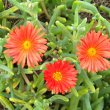
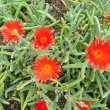
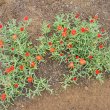
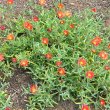
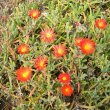
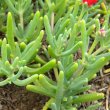
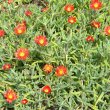


Discuss this plant
Share knowledge, ask a question or give an experience.